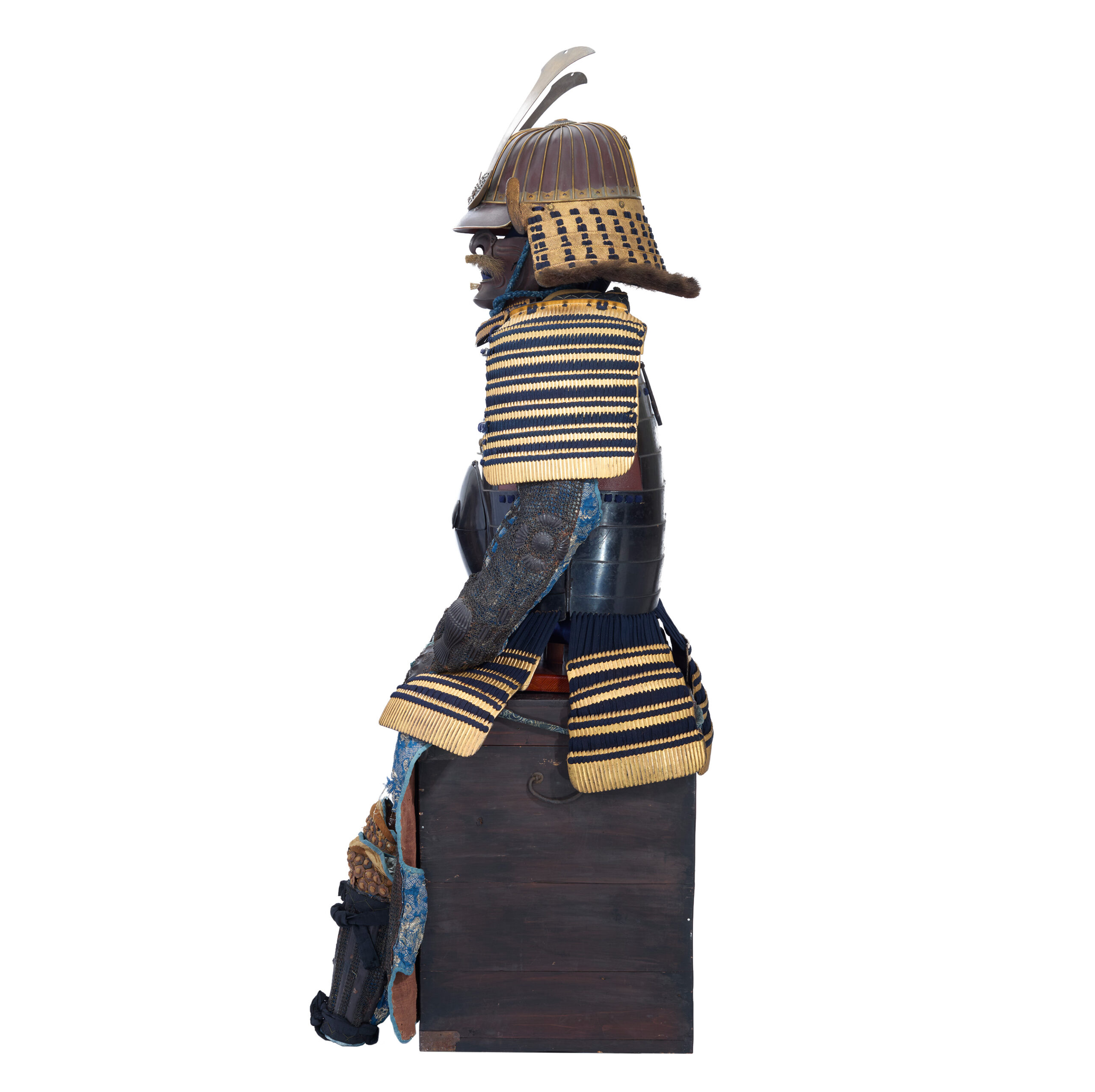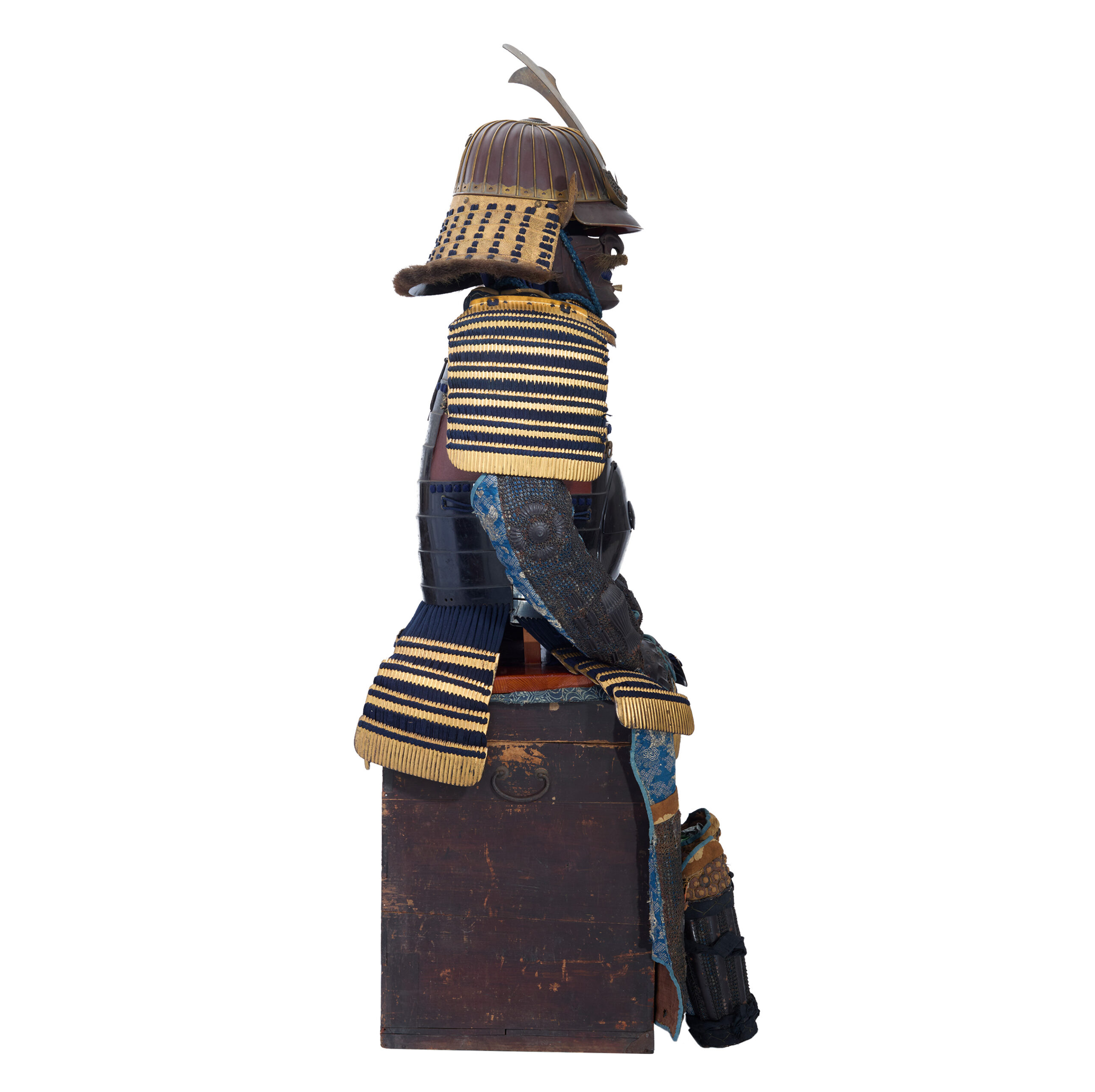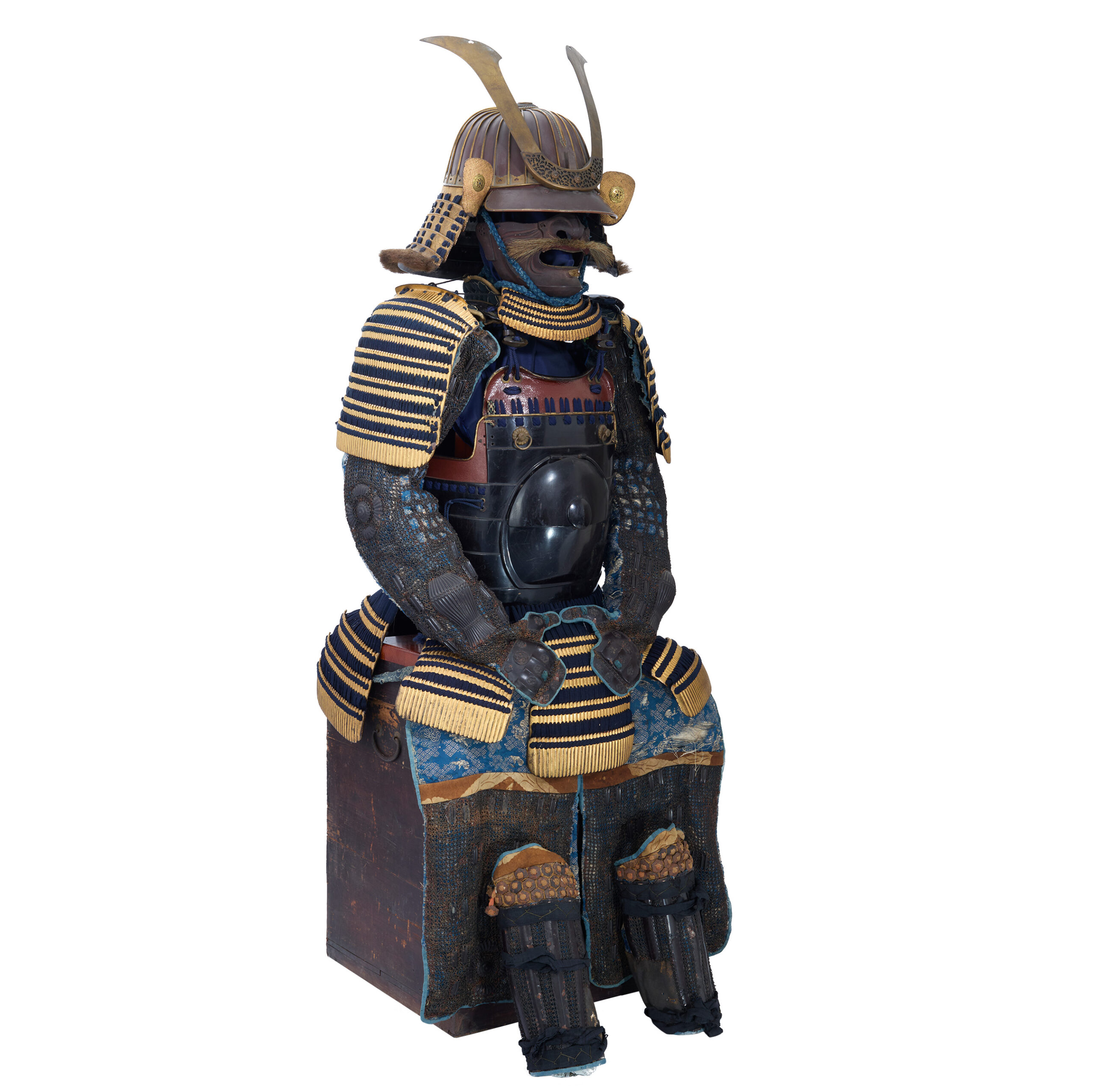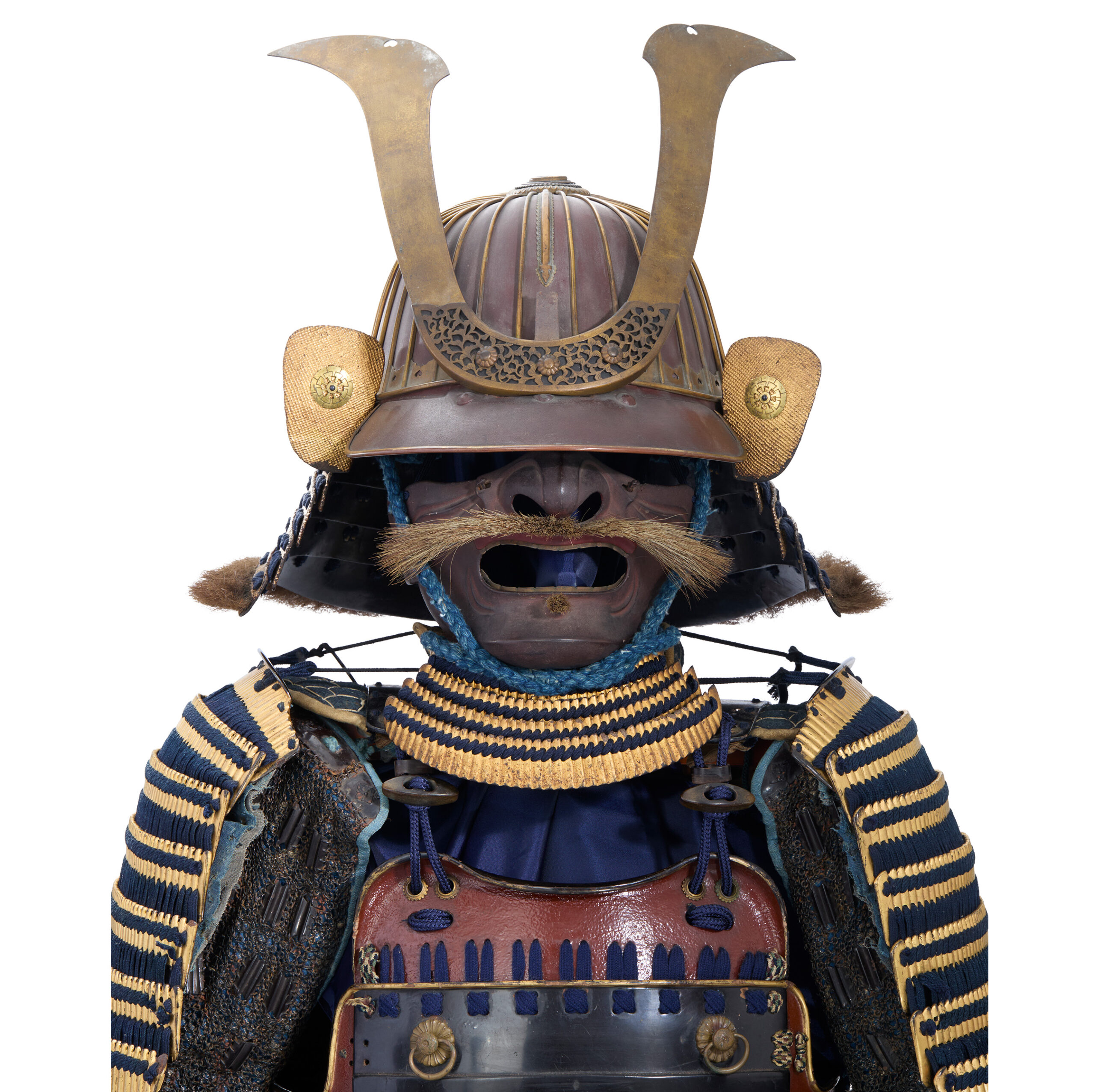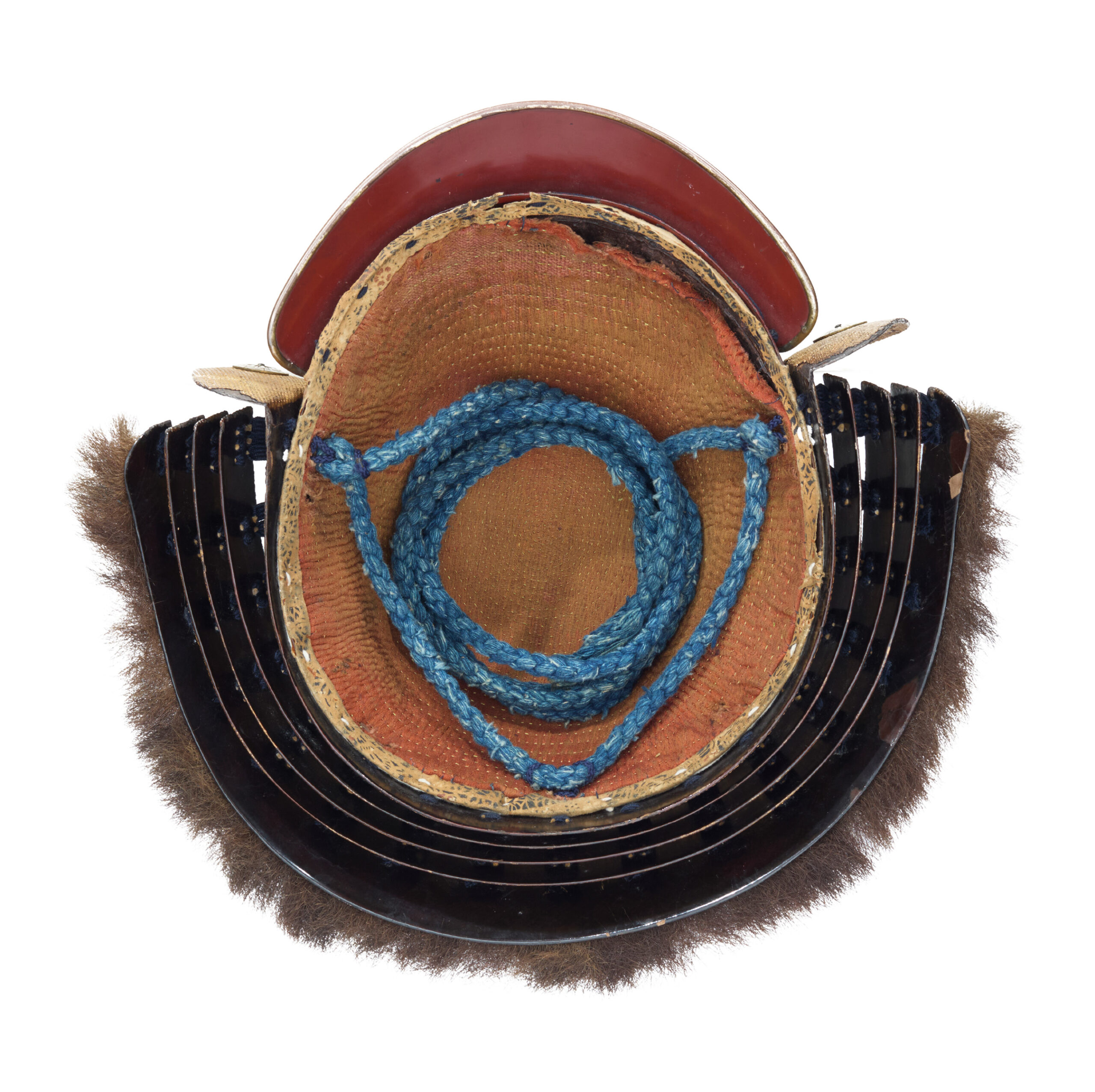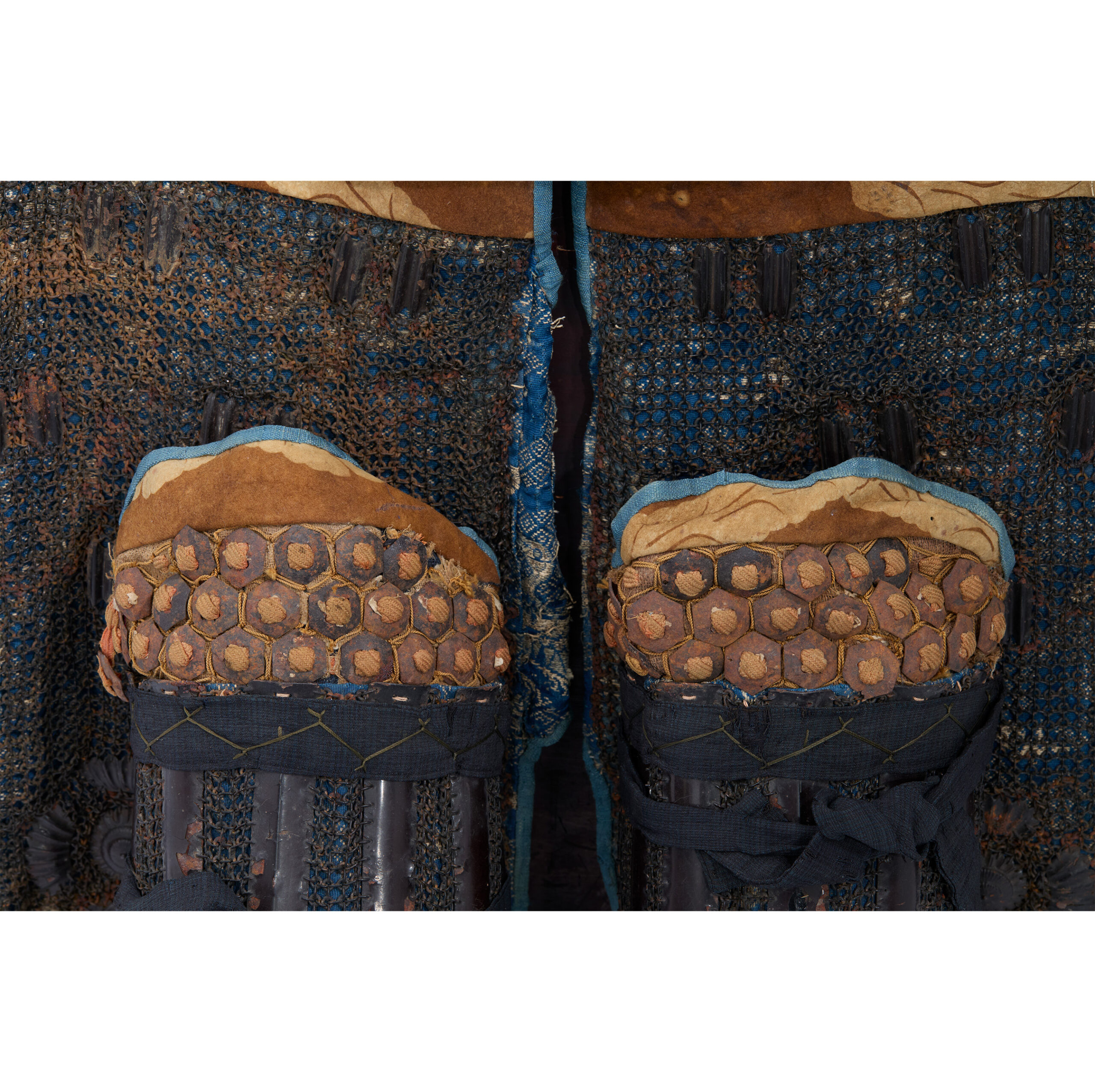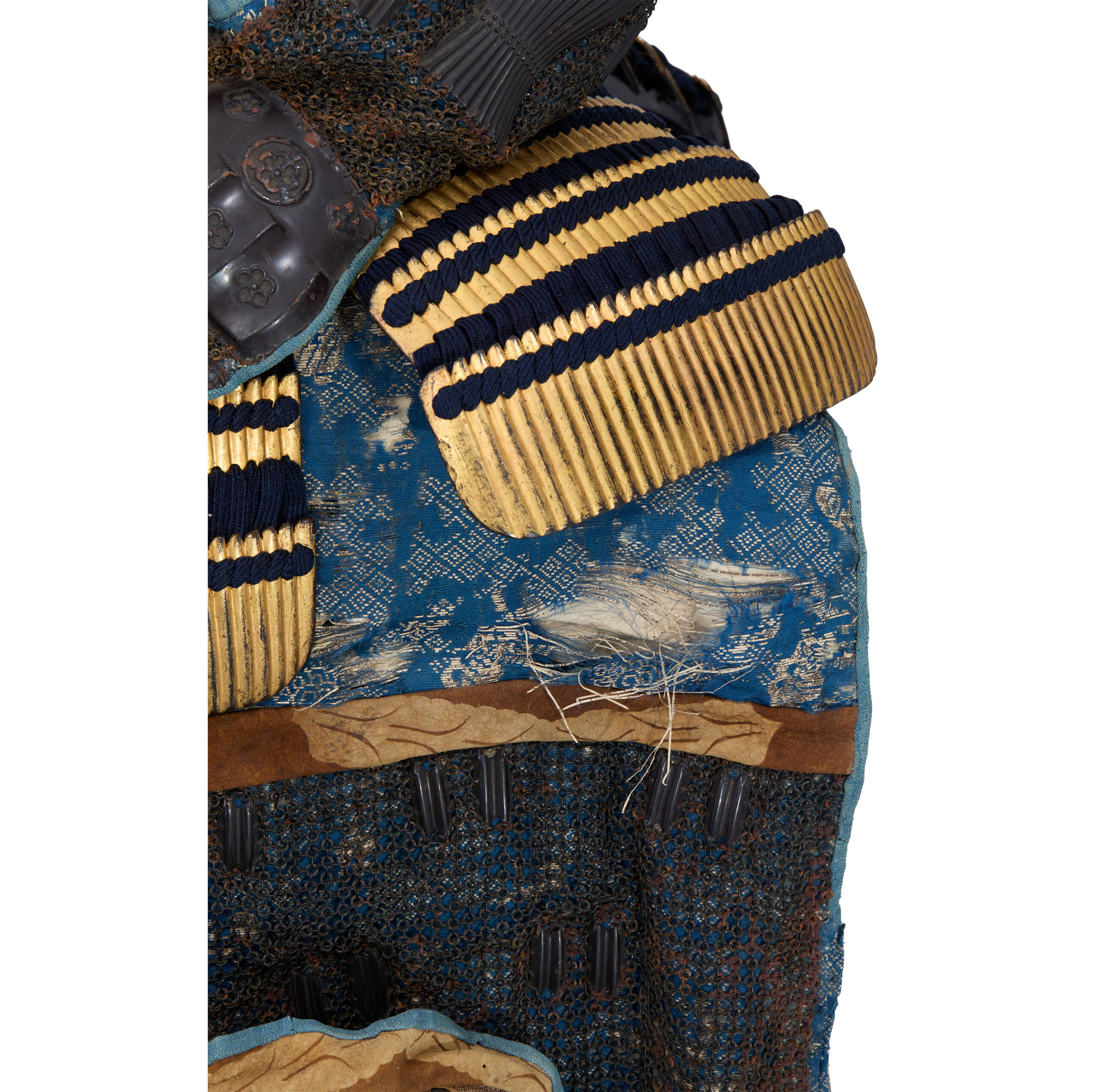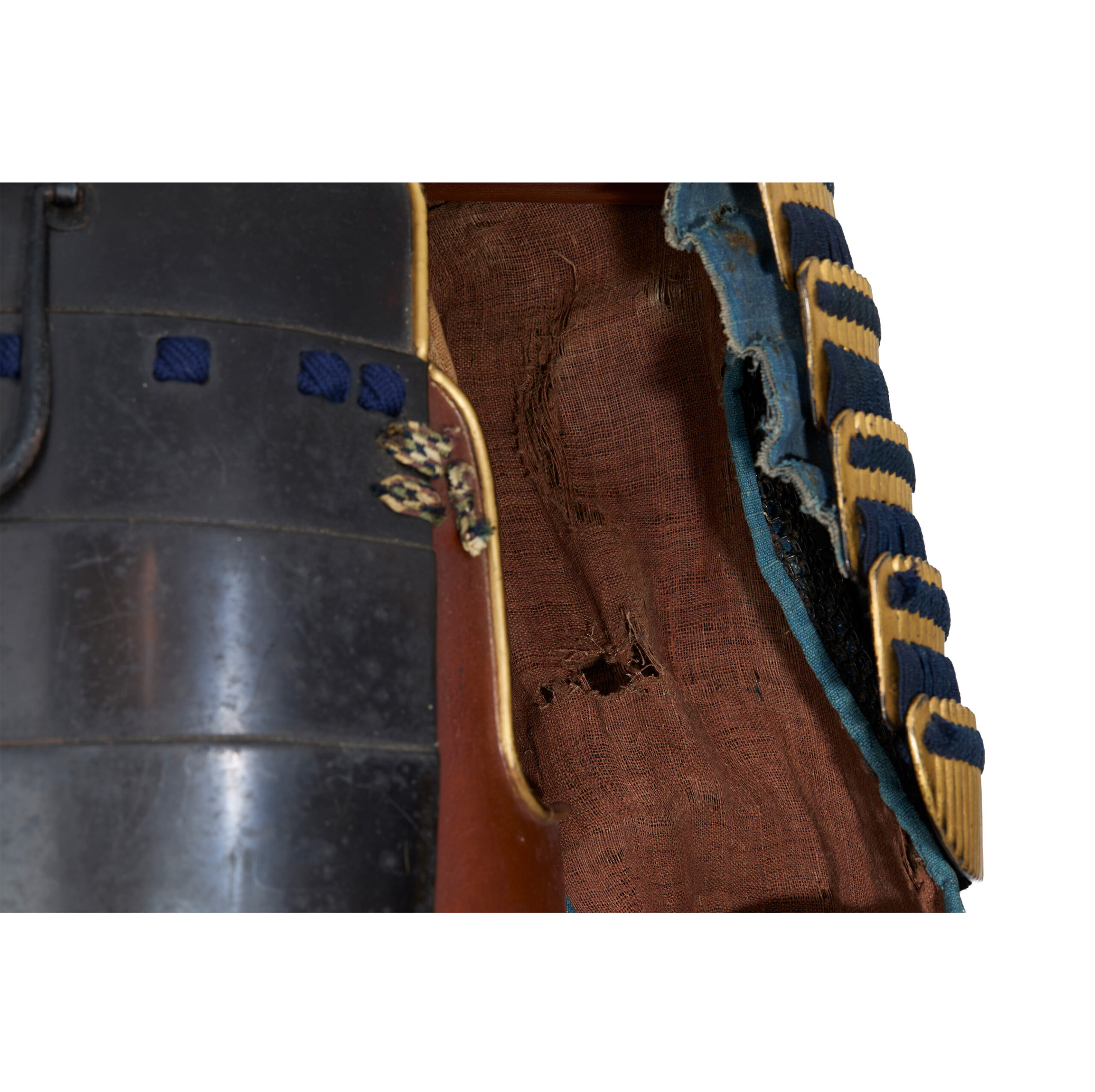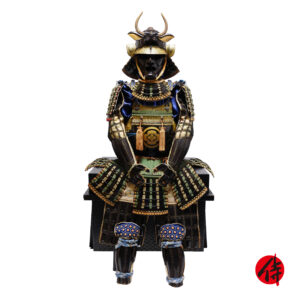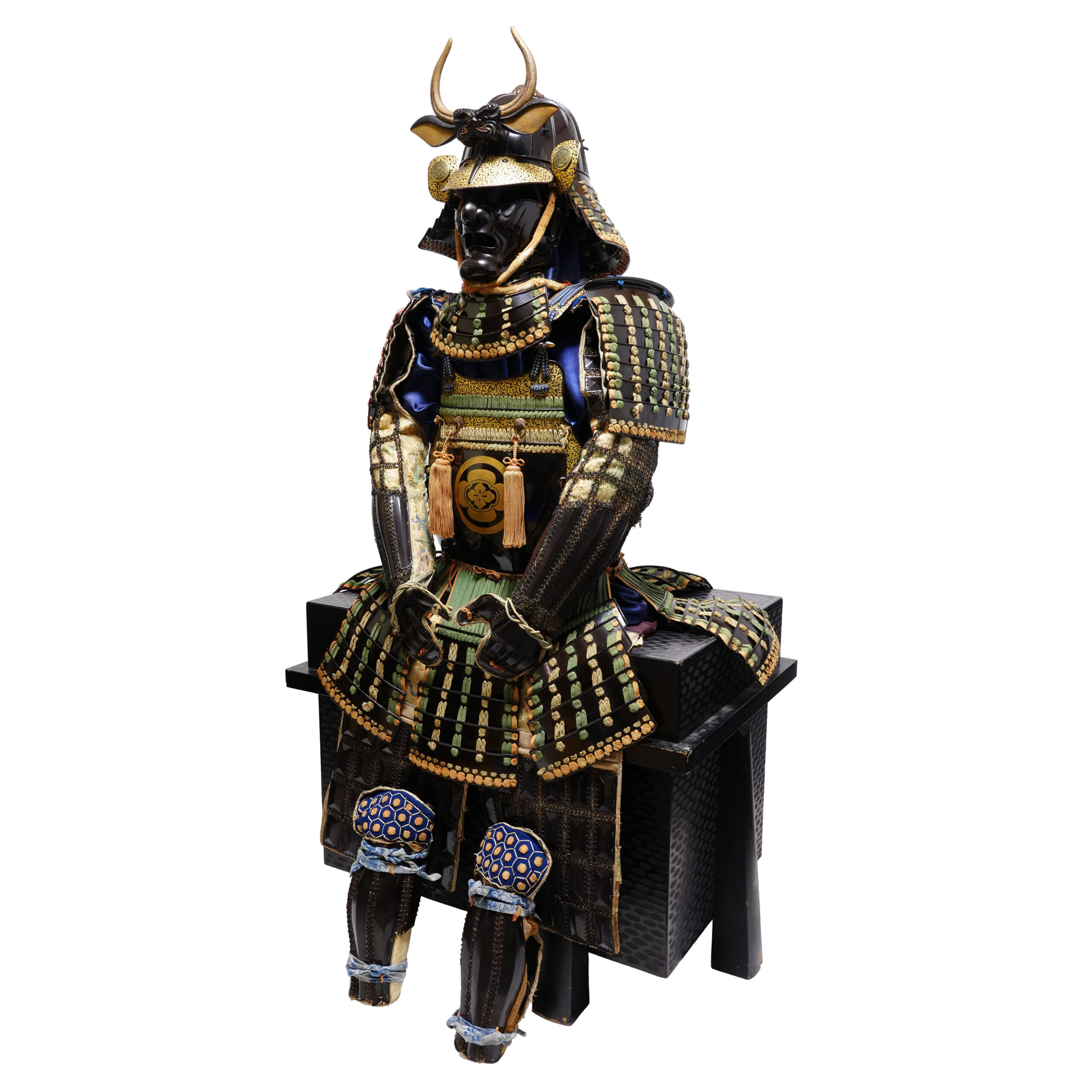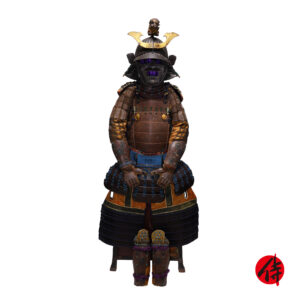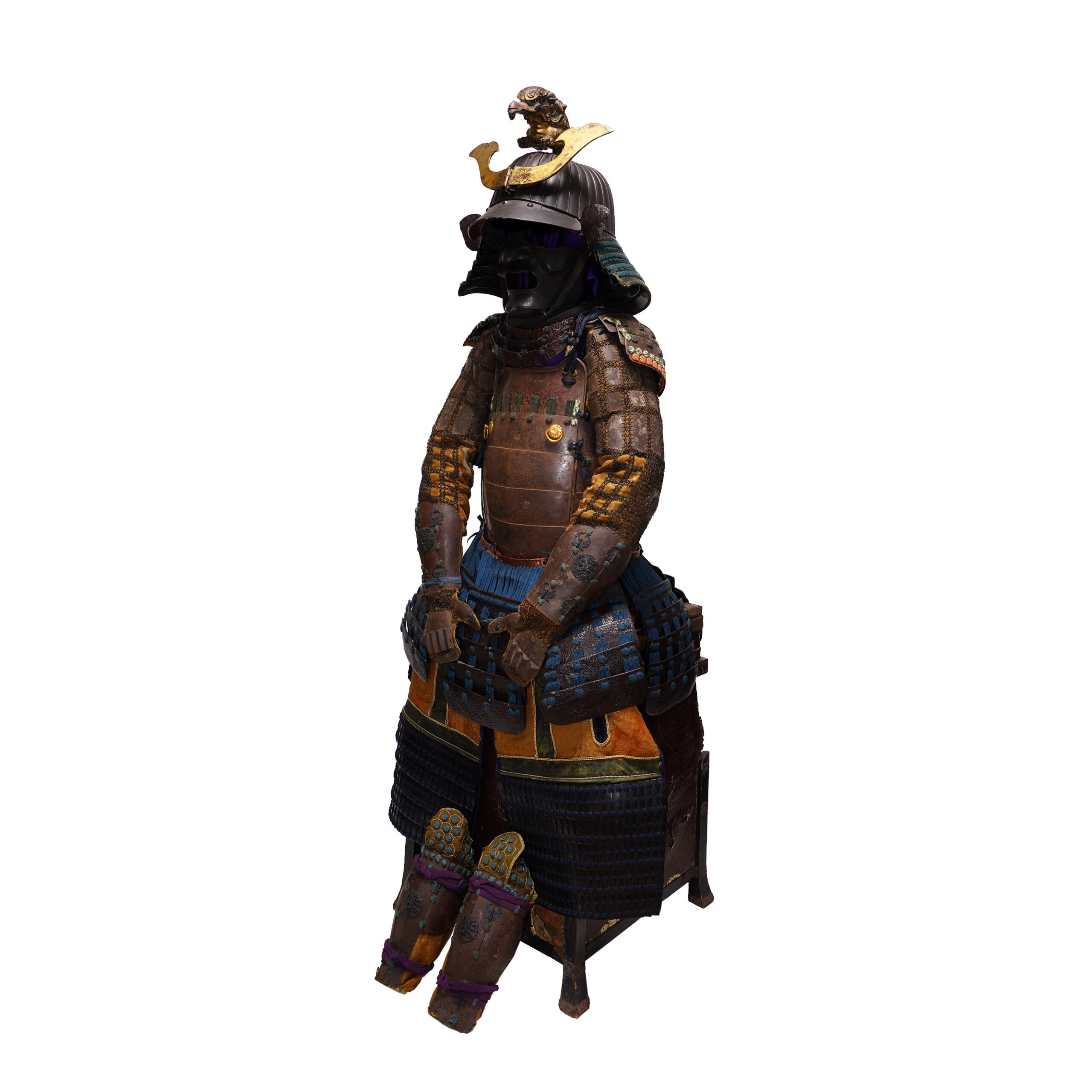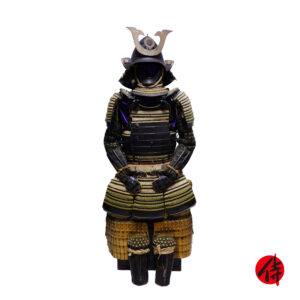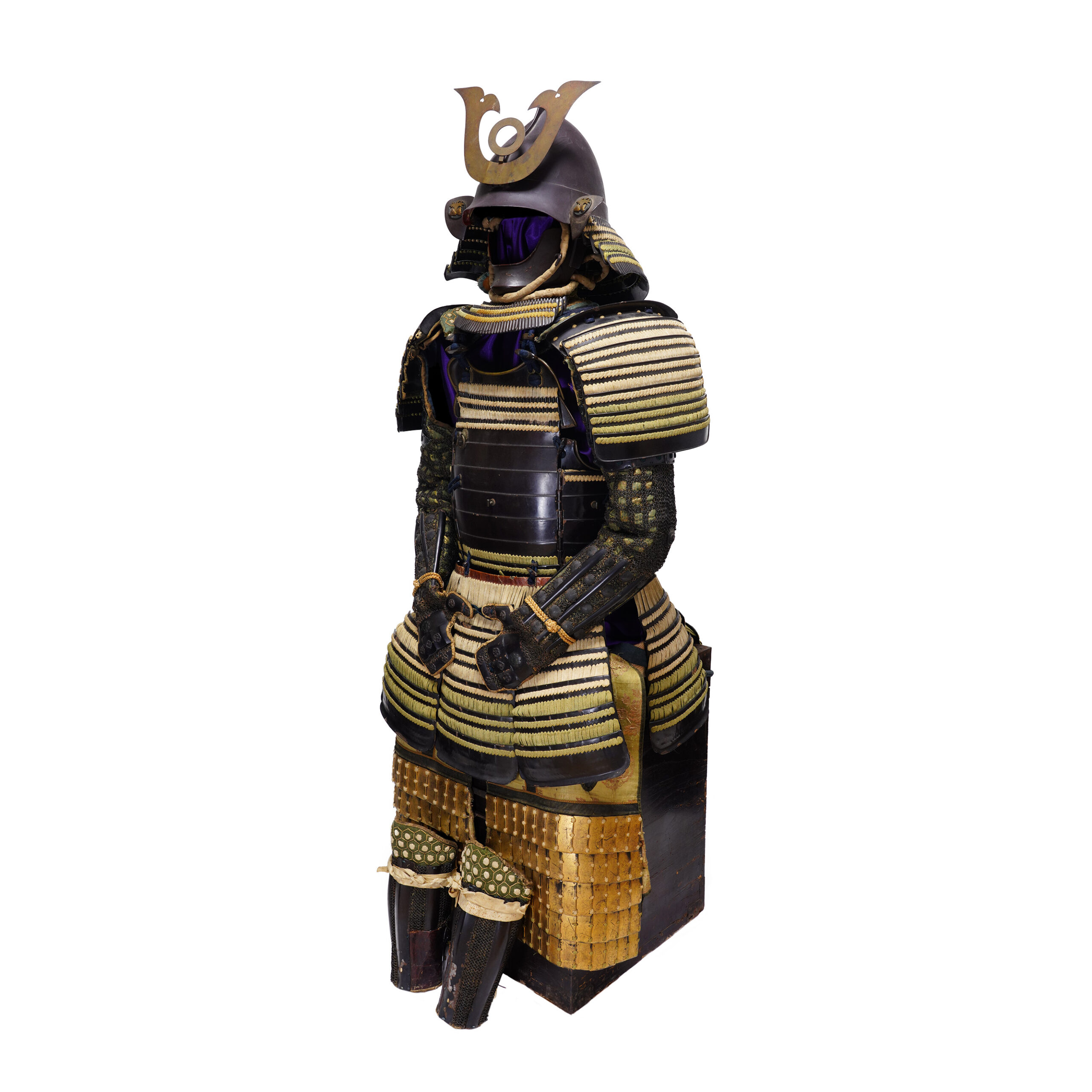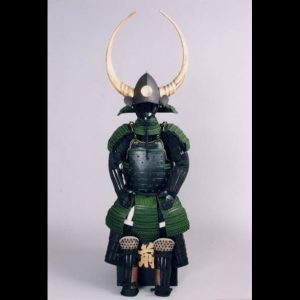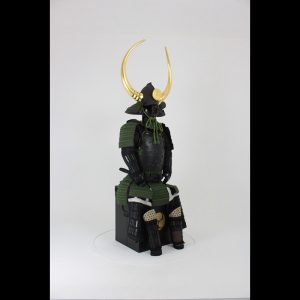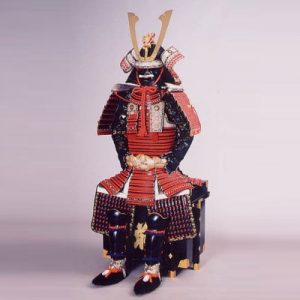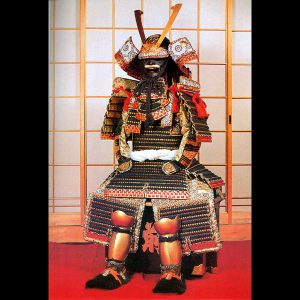Antique Late Edo Period Samurai Armor Tokubetsu Kicho Shiryo Certificate (A-42)
Period: Late Edo Period
appraised by The Association for the Research and Preservation of Japanese Helmets and Armor

Kabuto (helmet)
■Helmet bowl: Suji Kabuto
The Kabuto (兜, helmet) is a protector for the head. When people started using the Kabuto, it was initially designed for practical use. However, the principal purpose of its design has changed with time; Samurai warriors tried to express their dignity, personality, or religion by wearing the characteristic designed Kabutos. According to a theory, these uniquely designed Kabutos were made from the late Muromachi (室町後期, 1467-1573) to the Edo period (江戸, 1603-1868). This type of Kabuto is categorized as the Kawari Kabuto (変わり兜), and a variety of materials were used to create them. For example, animal fur, seashells, plants, and paper were used as materials for decoration.
Here we would like to introduce to you a little bit more about the history of Kabutos. Before the Kawari Kabuto’s production, the Suji Kabuto (筋兜) appeared during the Nanbokuchou (南北朝, 1337-1392) period. At that time, the tactic was gradually changed from the horseback fight style to battle with the Katana sword and the Naginata (薙刀, Japanese halberd) on the ground. Therefore, there was a rise in demand for the weight-saving of the Kabuto. Also, in order to turn the attack by swords, a new type of structure was invented: the Suji Kabuto (筋兜). Its form slides swords’ attacks when weapons hit the Kabuto. It is said that the production of the Suji Kabuto prospered in the Muromachi (室町, 1336-1573) period. We estimate this Kabuto is one of these Suji Kabutos made in that tendency in the Edo period. It has 25 stripes in this Kabuto, meaning 25 small iron plates are connected. It is called Nijuha Ken Suji Kabuto (二十八間筋兜). Niju Hachi means 28 in Japanese.

■Shikoro (side neck guard):
Gold lacquered plates laced with green and navy blue threads.
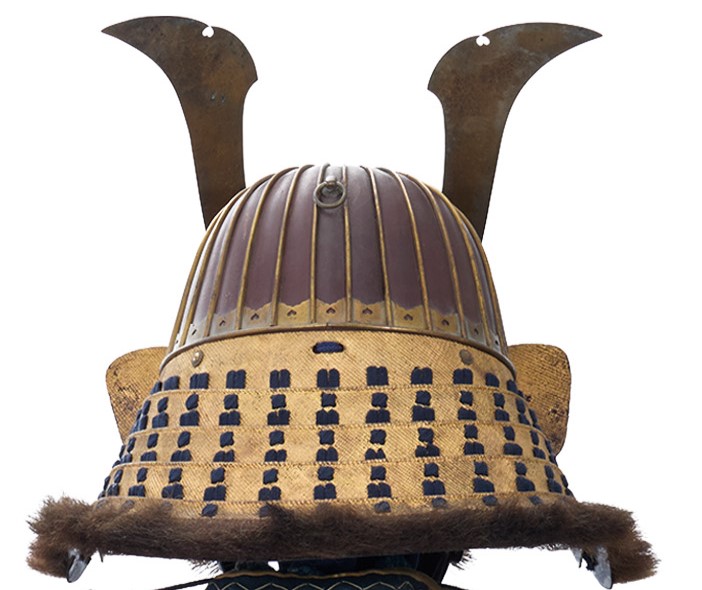
■Fukikaeshi (side neck guard)
The Fukikaeshi (吹き返し) is both ends of a Kabuto. It protects the face from swords. On each side of this FUkikaeshi, there are “Genji-guruma (源氏車),” a type of family crest. This crest is based on the design of a palace carriage and is one of the most common crests in Japan, particularly associated with the Sato (佐藤) family name. A famous Samurai who used this crest were the Sato brothers, who served under Minamoto no Yoshitsune (源義経).
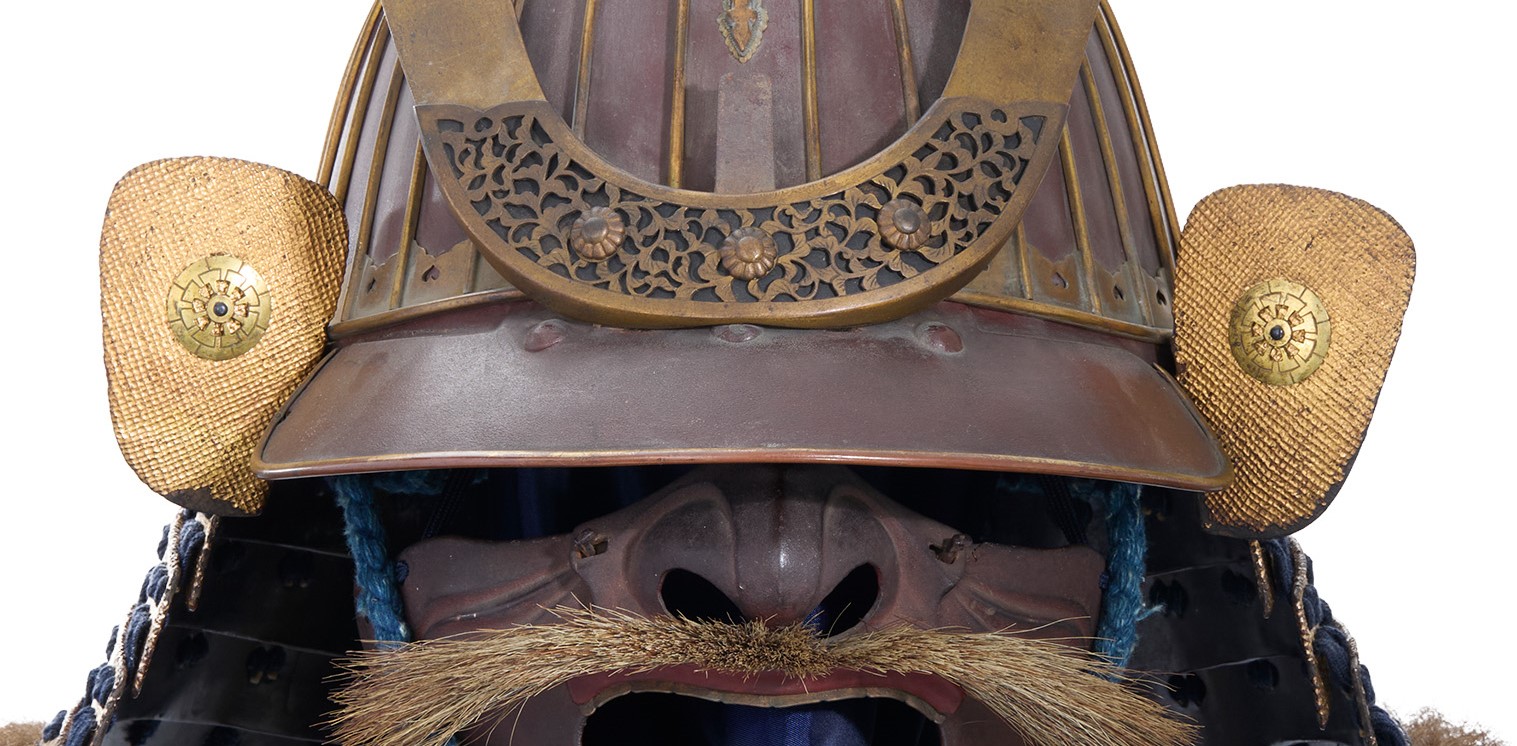
■Menpo (face guard): Ressei Menpo
This type of Menpo is called the Ressei Menpo (烈勢面頬). It represents the angry face to intimidate enemies. There are many types of Menpo, depending on their shape or appearance. The purpose of Menpo was not only to protect Samurai’s face. But also to hide their true faces so that their psychological states were unaffected. Long beards are attached to this Menpo. Thanks to this effect, even a young soldier would have been able to produce the majestic appearance of a middle-aged Samurai.
*We would like you to keep in mind that the the Menpo in the authentication Paper is different from the one shown on this page. However, the Menpo we will be delivering is the one shown here. Thank you for your understanding.
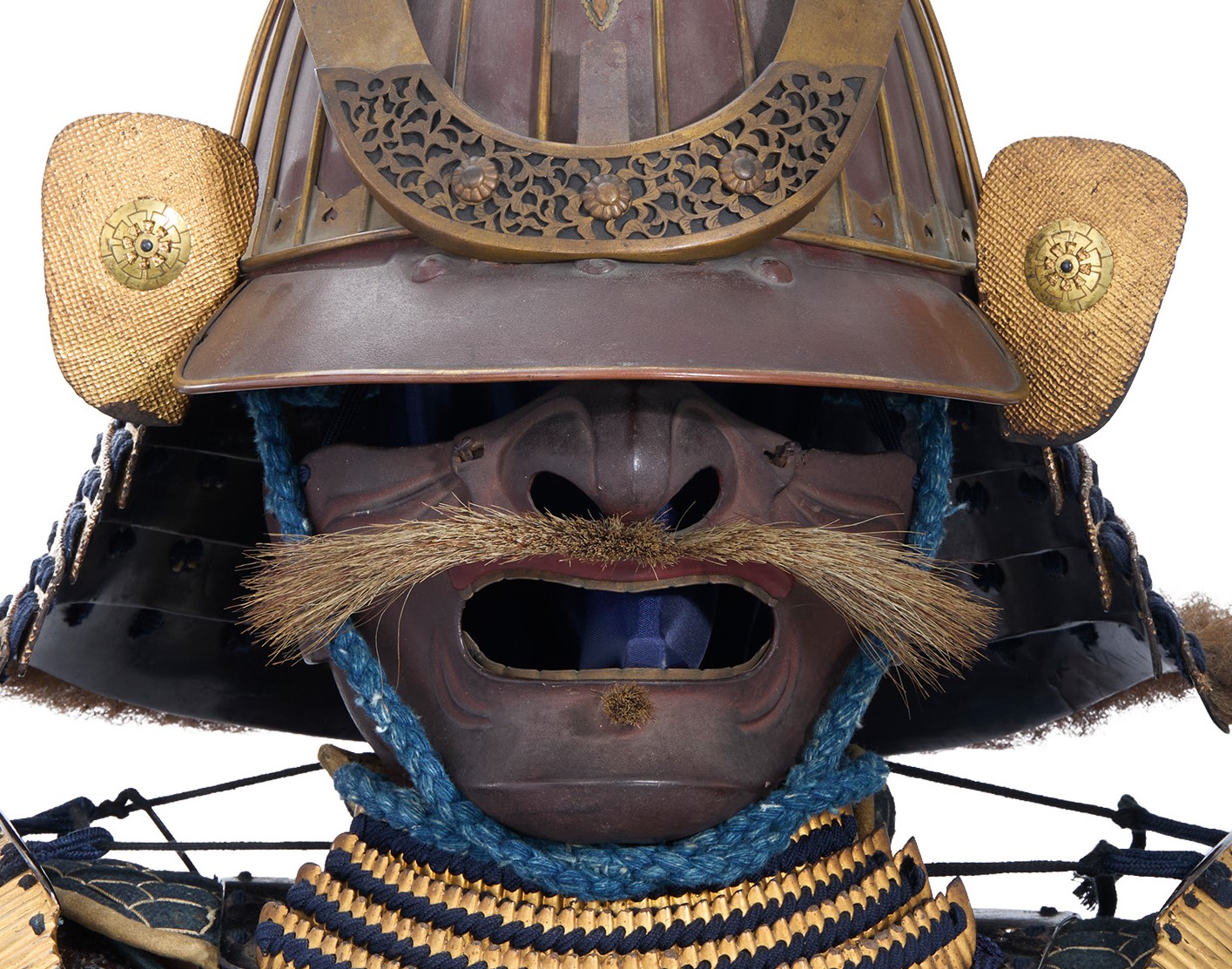
■Kuwagata (Front decoration):
The Maedatemono (前立物, front decoration) is attached to this Kabuto. We estimate its shape imitates a type of the moon called a Mikazuki (三日月, crescent moon). We imagine that its golden color caught people’s eyes on the battlefields. According to a theory, the crescent moon designs of Maedates came from the Myouken (妙見) belief. This religion was born in India. It was mixed with the Polestar belief and was brought to Japan from the continent. In the Myouken belief, the moon and stars were the symbols of faith. The Myouken Bosatsu (妙見菩薩, 菩薩 means Bodhisattva) fulfills all wishes such as fertility of rich harvest, peace, the prosperity of the clan, healing of illness, longevity, success in business, traffic safety, academic achievement, marriage, etcetera. Reasonably, the moon motif for a Maedate was popular among Samurai warriors. The former owner of this armor might have shown his faith by wearing this Kabuto. One of the famous Samurai who used this type of Maedate was Date Masamune (伊達 政宗, 1567-1636). He took over the family estate at the age of 17 and contributed to the prosperity of the Touhoku (東北) region. It features a sizeable crescent-shaped decoration and is a popular design even in modern times for replica products.
Also, the ends of the Mikazuki are decorated with Inome (猪の目, boar’s eyes) , and the central part features Kiku-karakusa (菊唐草, chrysanthemum arabesque pattern). The Inome pattern has been used since ancient times. As its name implies, the boar’s eyes are the origin of this pattern. Some people believed the Inome design would work as an amulet to protect them from evil spirits or fire. Also, it is said it would bring good luck. The Karakusa pattern is a design in which stems and leaves of vines are twined and make curves. Since ivy has a strong vitality and grows up without interruption, people regarded this design as a symbol of prosperity and longevity. Such auspicious meanings might have inspired this Fuchi Kashira’s design.

Armor
■Do (cuirass): Okegawa Nimai Do
Nimai Do is a kind of cuirass for Tousei Gusoku (当世具足, developed armor style). Nimai Do (二枚胴) was named after the fact that Nimai (二枚) means two plates, and Do (胴) means torso in Japanese. Instead of using a large number of small lamellar plates called Kozane (小札), this cuirass used large iron plates riveted.
The name Okegawa (桶側) came from the fact that the shape of this cuirass resembles the Gawa (側, side) of Oke (桶, Japanese wooden tub). The body armor part can be separated into two pieces and connected with a hinge. Generally, a hinge is located on the left side, and you could tighten a cuirass on the right side. The Okegawa Do was relatively easy to make and had high strength; therefore, it is said this style of cuirass became popular in the latter half of the Muromachi (室町, 1336-1573) period.
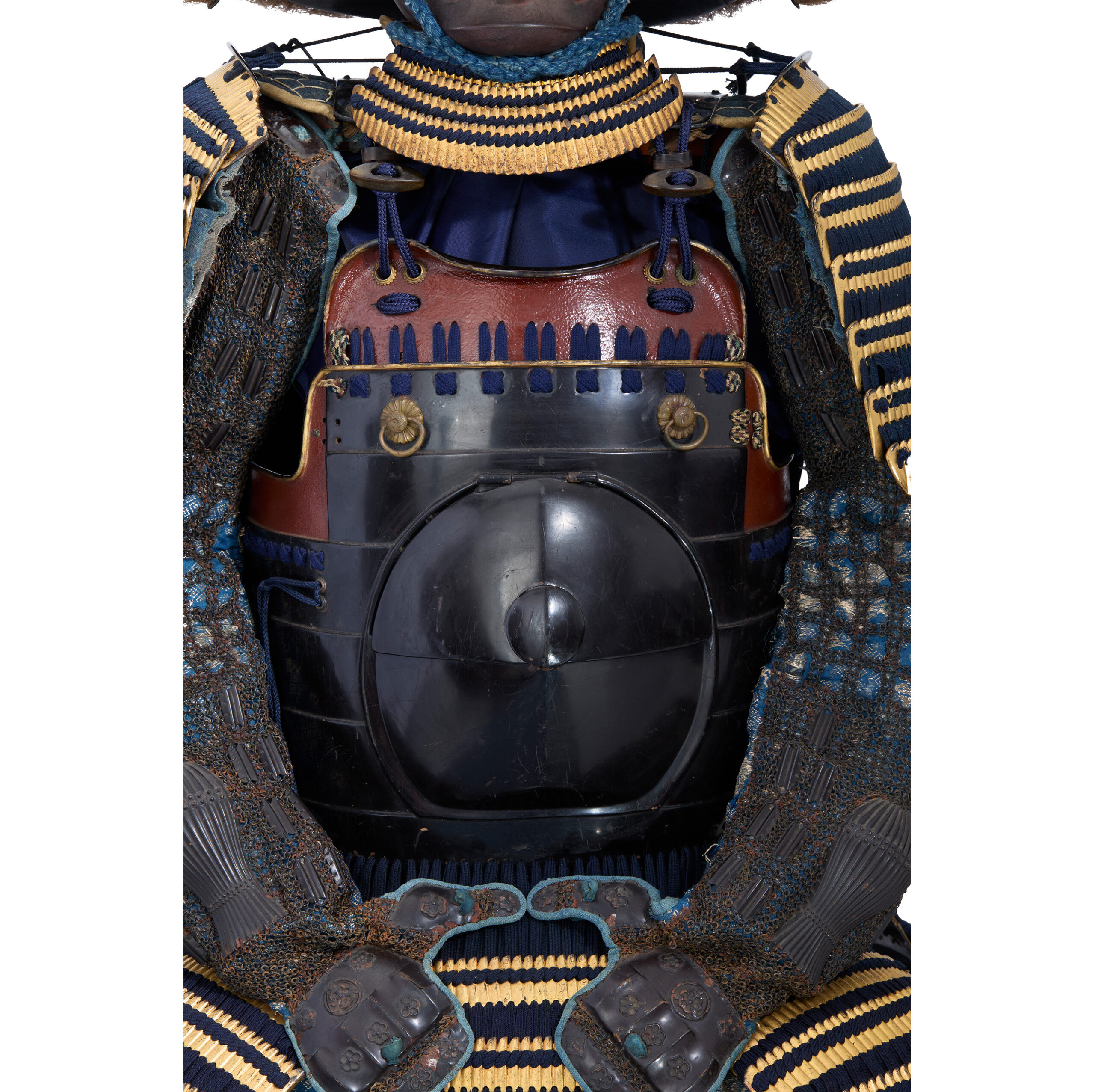
■Ruri-Sai
Rurisai (瑠璃斎) refers to a style where part of the chest plate can be removed or opened and closed using hinges. It is believed to be named after a military scholar from the Kanei period (1624-1644). Its purpose is thought to be allowing the storage or retrieval of items without removing the armor, but this is not definitively confirmed. As you can see from the photo below, you can find a pocket on the body armor. When you move the round shaped button in the center of the pocket down, it closes itself.
金泥書(Kindeisho) is written inside the pocket. It says 枩邑恵作(Matsumura Megumi Saku). We believe this Do was made by him. Kindeisho is a kind of writing made from high purity gold powder mixed with nikawa (a kind of gelatin). This kind of writing is often found in Buddha statue and scripture.

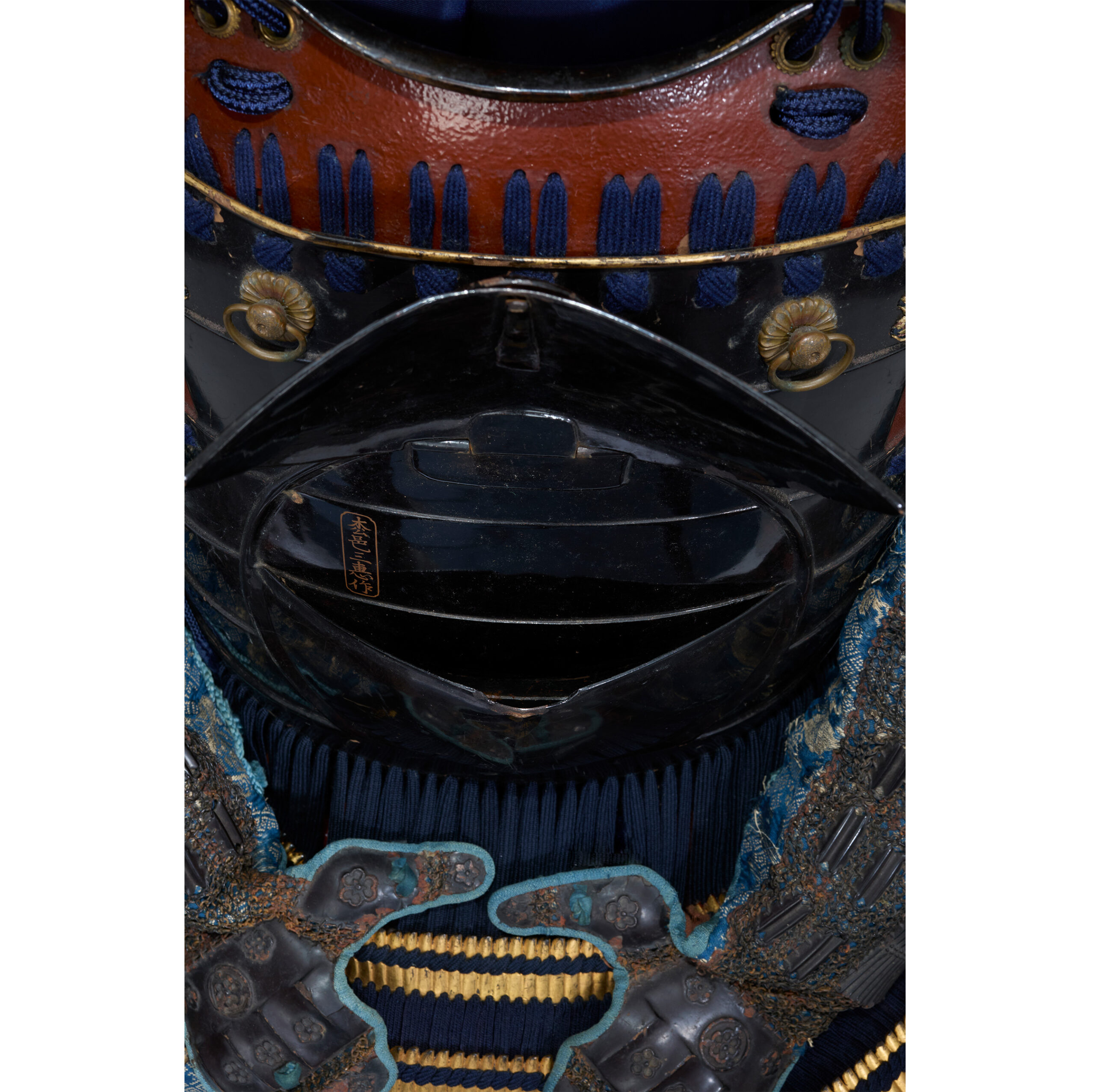
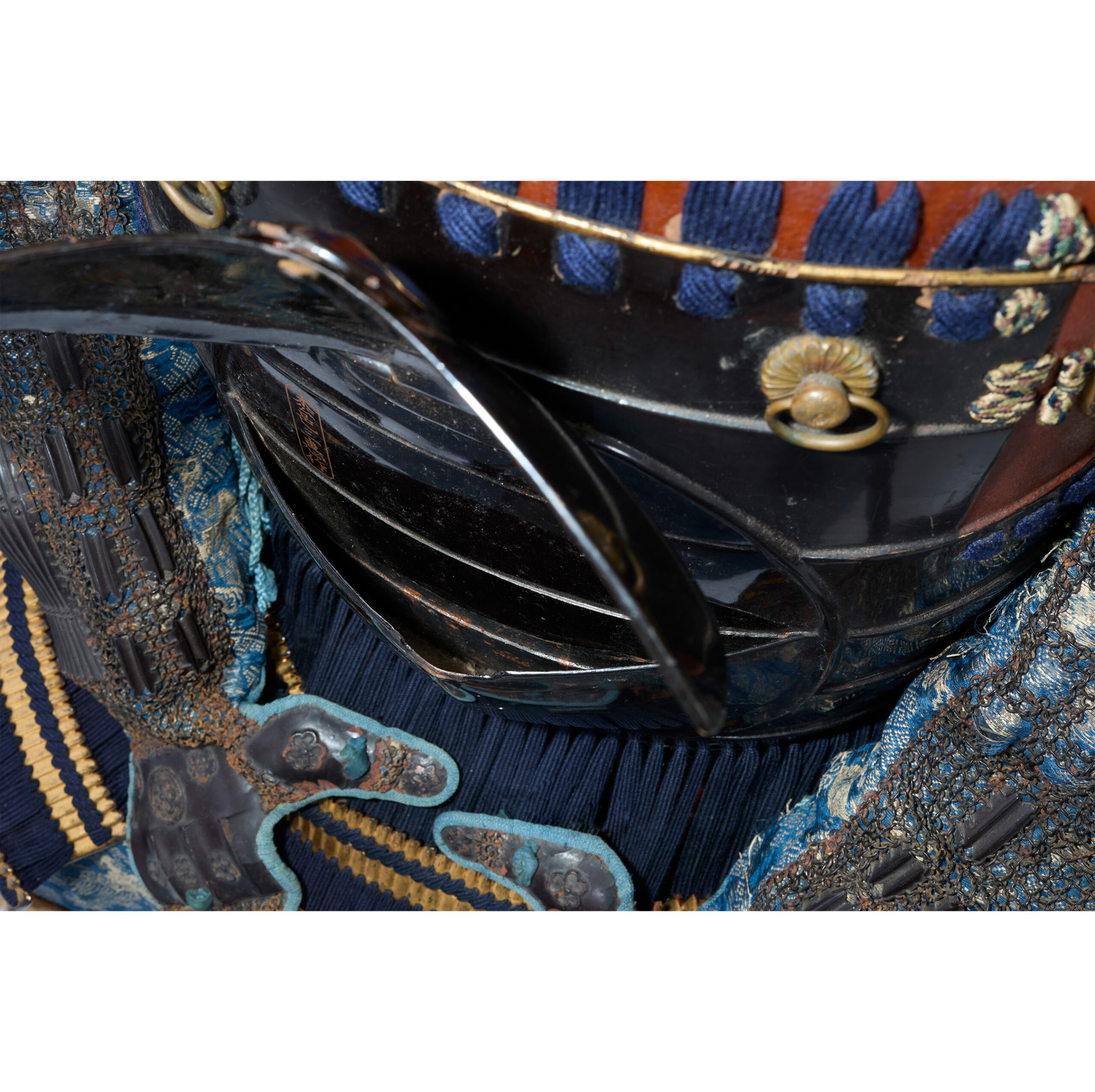
■Kusazuri (skirt of plates attached to the cuirass):
Gold Lacquered iron Kusazuri laced with navy. The cords for the Odoshi (縅, a technique for armor tying boards together with cords such as leather or thread) are relatively in good condition, so each plate is tied without coming off.

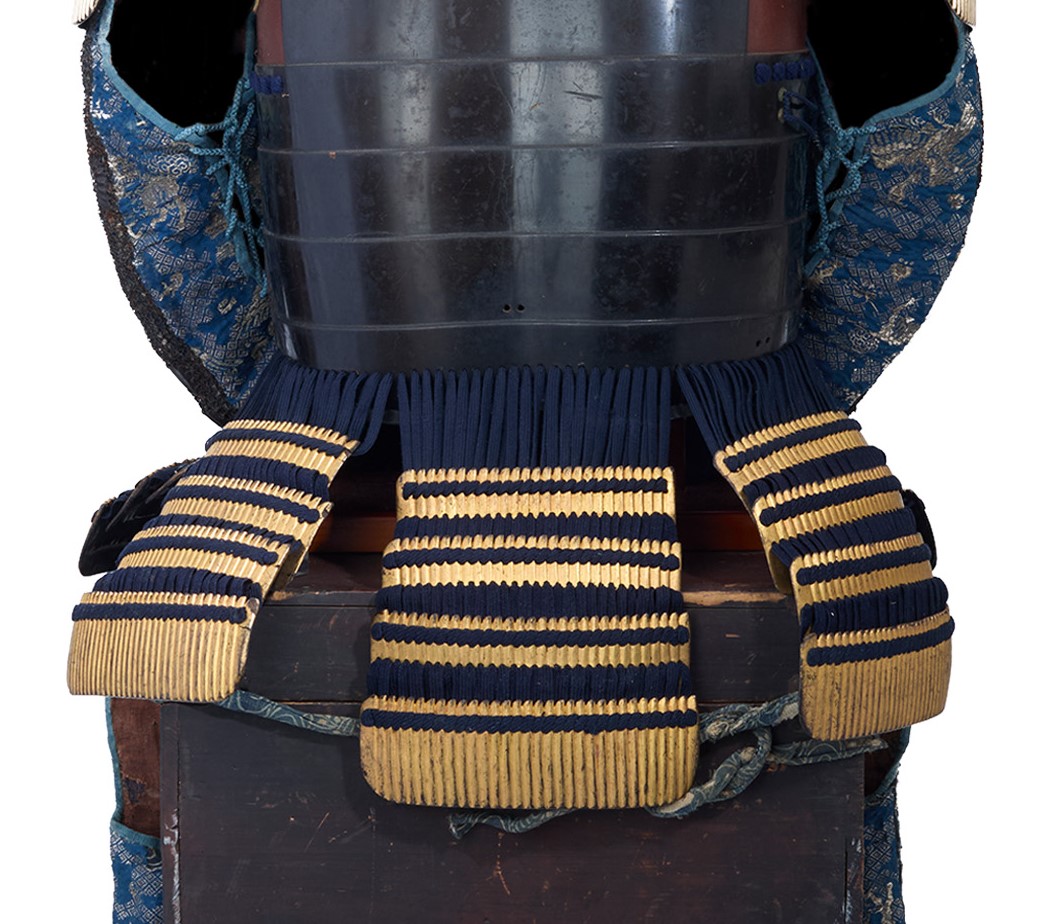
Small parts
■Kote (armored sleeves):
Intricate iron chain mail with silk.
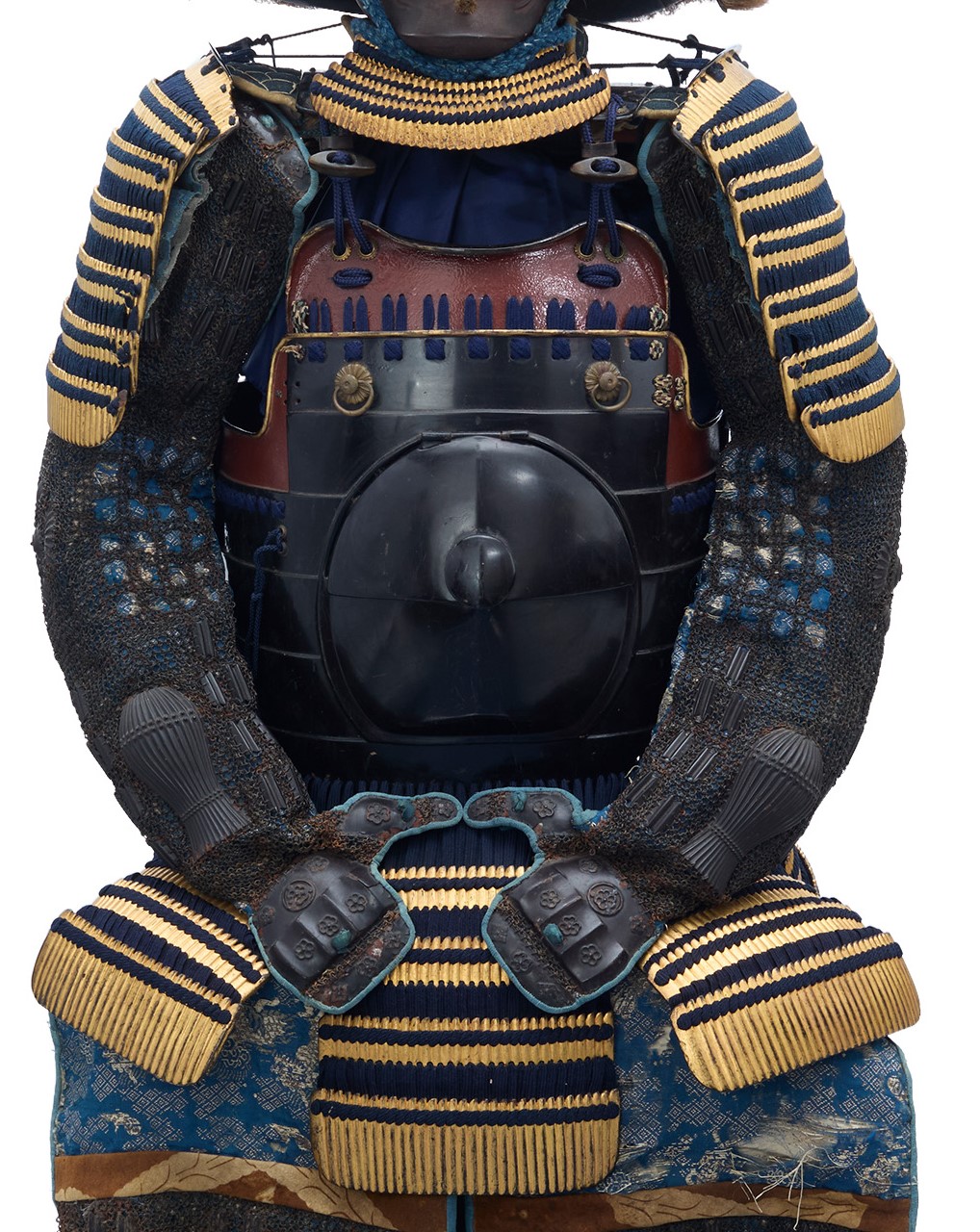
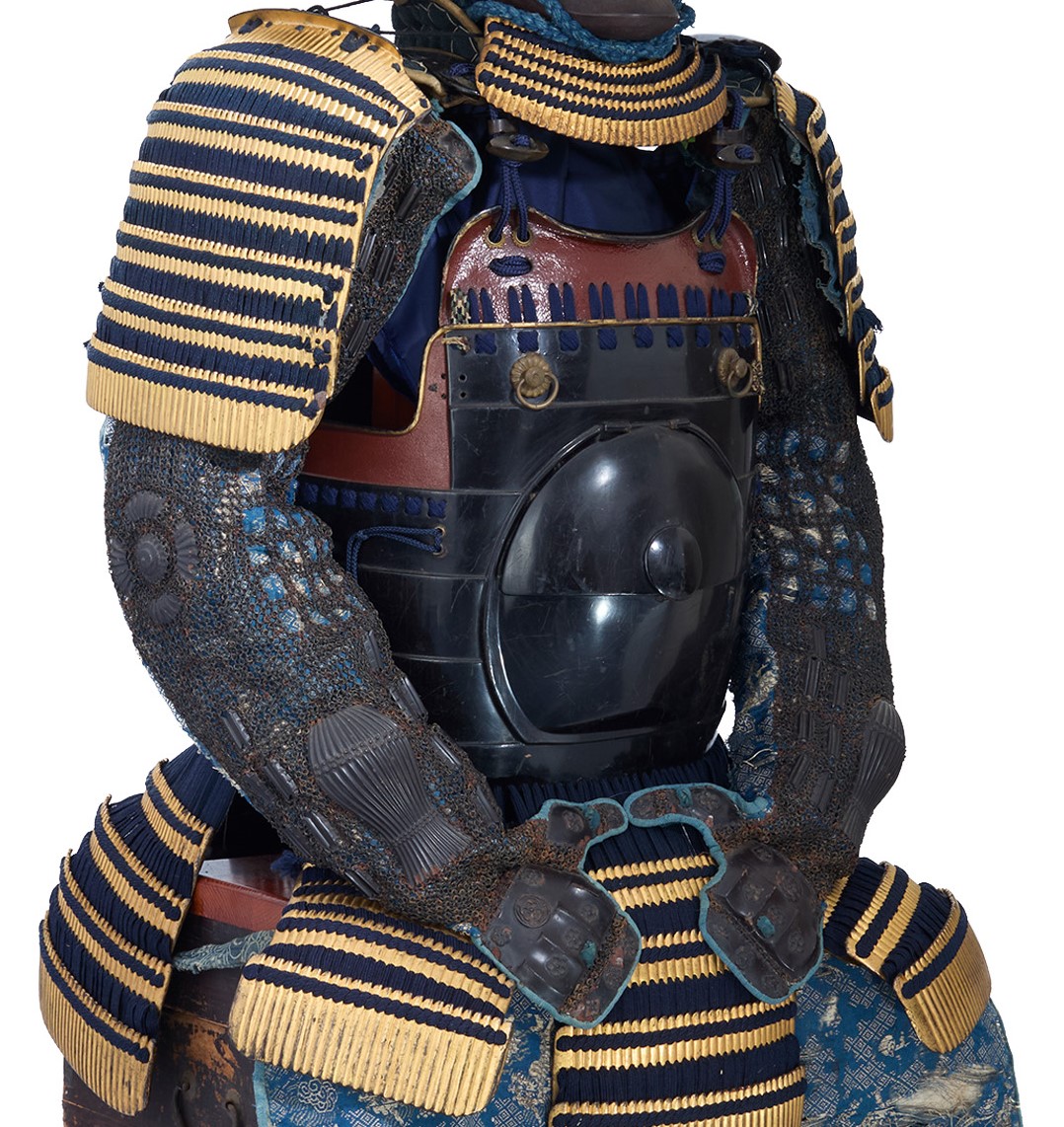
■Haidate (thigh protection):
The Haidate (佩楯) is a thigh guard. Chain mail and iron plates are attached to its cloth.
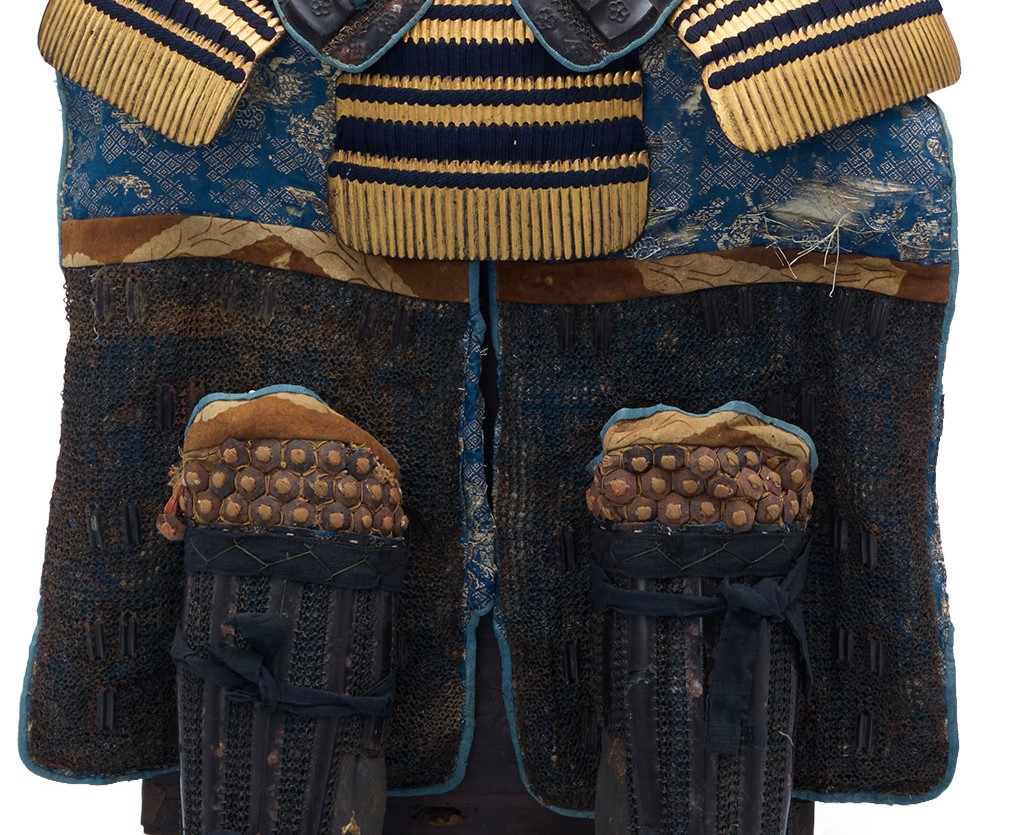

■Suneate (shin guard):
The Kikkou (亀甲, turtle’s shell) pattern is used for the cloth of the Suneate (脛当). It is a continuous geometric pattern connecting regular hexagons up and down. A theory says that this design was brought from China and the Korean Peninsula during the Asuka (飛鳥, 592-710) and Nara (奈良, 710-794) periods. A proverb says turtles live long lives; therefore, turtle and turtle shell patterns represent longevity. In addition, as this continuous hexagonal pattern does not get out of its shape, it is said people wished for eternal prosperity by using this design.
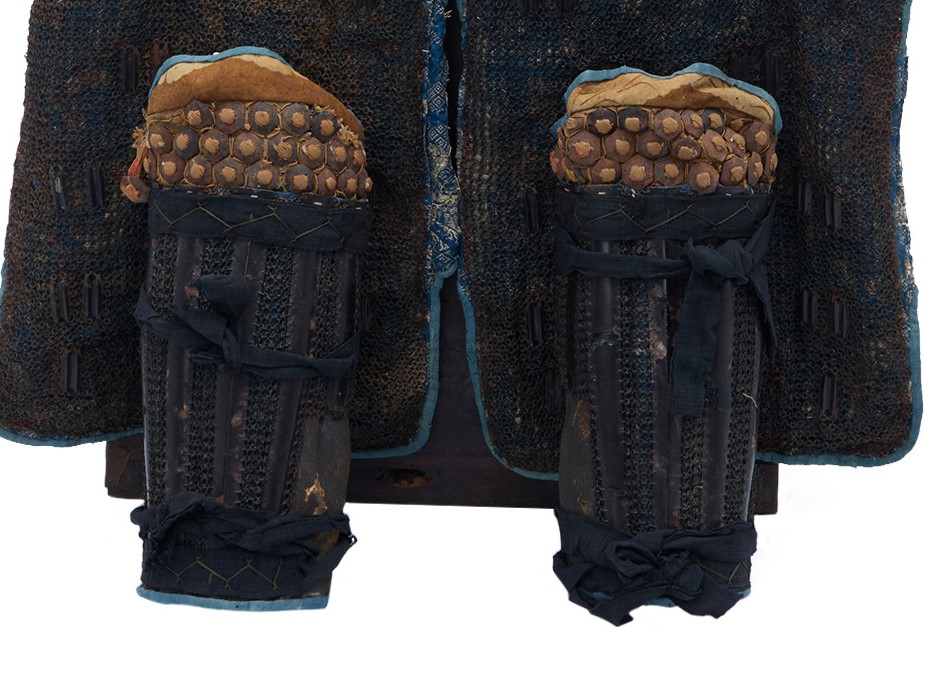
Certification: Tokubetsu Kicho Shiryo Certificate
On August 27th 2023, this armor was appraised as a Tokubetsu Kicho Shiryo by The Association for the Research and Preservation of Japanese Helmets and Armor, which is the most trusted Japanese armor appraiser in Japan. This association is also known as Nihon Katchu Bugu Kenkyu Hozonkai (日本甲冑武具研究保存会). Tokubestu Kicho Shiryo (特別貴重資料) means special rare article. It is ranked as the third highest of five rankings. The paper mentions the armor was made in the late Edo period. You can receive this original authentication paper.
*Please keep in mind that the the Menpo in the authentication Paper is different from the one shown on this page.
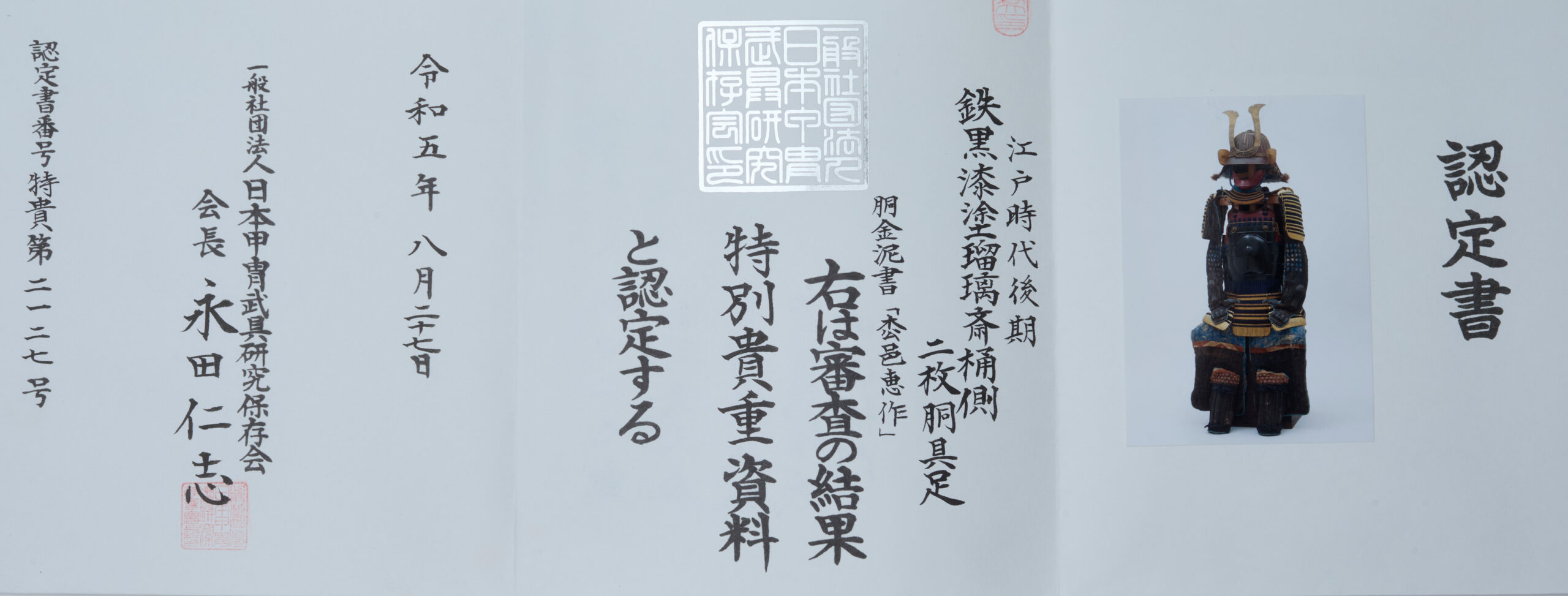
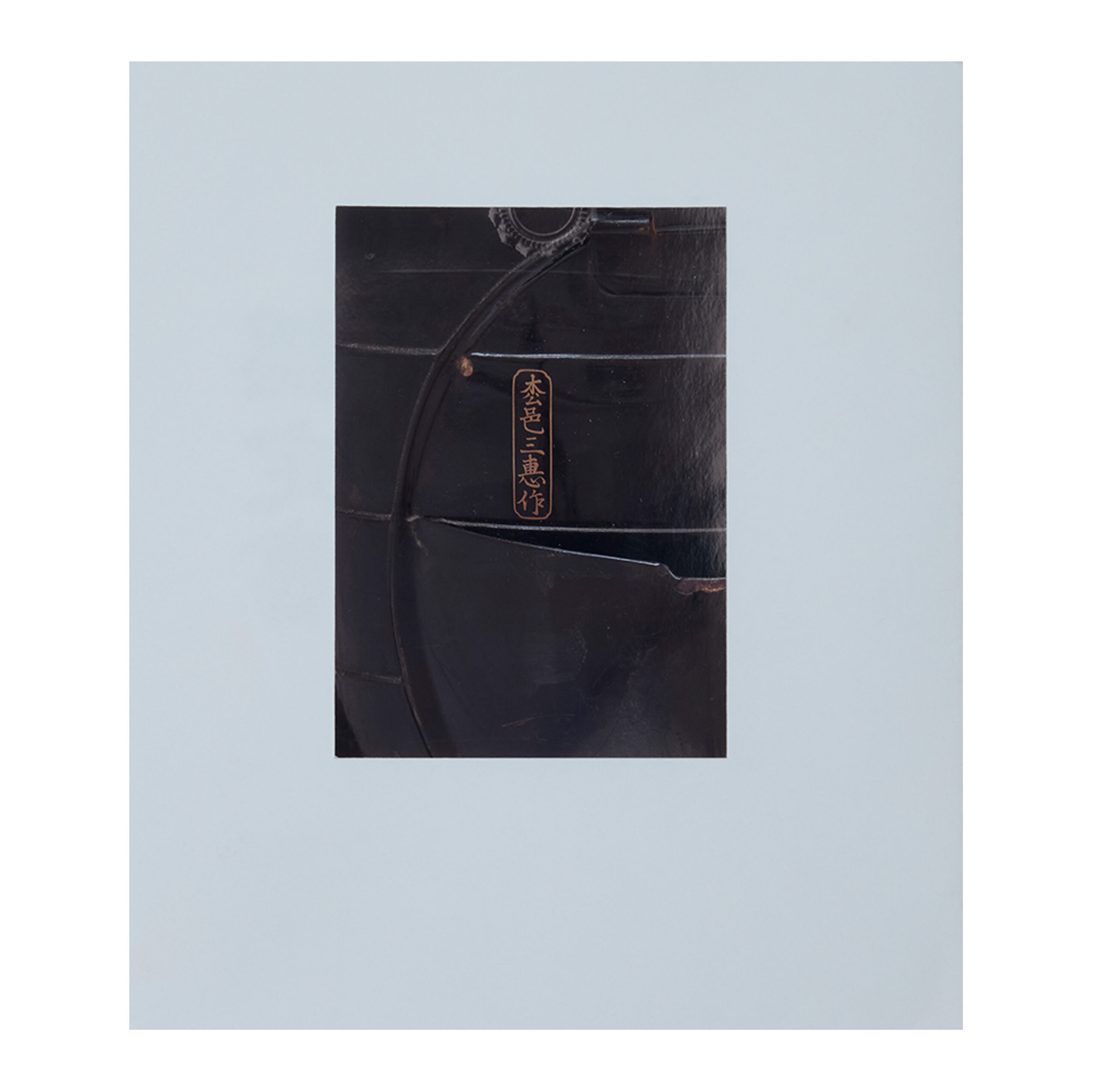
An English translation of the certificate is available on request. We won’t charge any additional fee.
【About us】
Samurai Museum is located in Tokyo, Japan, exhibiting antique artifacts related to the Samurai history. Samurai Museum Shop is the place for those who are interested in Japanese culture and craftsmanship. We deal with antique Samurai swords/armor, traditional crafts made in Japan and so on.
【Antique Japanese Armor and Export process】
After receiving the full payment from you, we will apply for its export permit from the agency for Cultural Affairs to legally export the antique Samurai armor to other countries. It normally takes around 2-4 weeks to receive this permit. And we would like you to expect at least 1-1.5 months for your order to arrive at your given address after you ordered.
【Payment method】
We accept payment through Stripe (Credit card), PayPal, Apple Pay or ChromePay, all of which are secure payment methods. Also, you don’t need to make an account on Stripe for the checkout. If you prefer other payment method, please contact us. You may either pay in JPY, USD, AUD, CAD, EUR, CHF or GBP. The price is set in Japanese Yen. Prices in other currencies are automatically calculated based on the latest exchange rate.

【Shipping duration】
We normally ship via EMS (Express Mail Service) provided by Japan Post. It usually takes at least 5-14 days to deliver the package after you place an order. We offer Free International Shipping as long as we can ship your order by EMS. If you prefer other shipping carriers, please contact us.
We will inform you of the order’s tracking number via email. Please make sure you fill out your valid email address correctly.

【How to make sure the condition】
Please keep in mind that what you are going to purchase is an antique item. We uploaded high resolution photos for you to check its condition thoroughly. If you like to see more photos with different angles, please feel free to contact us. We will be happy to send them to you so that you can make informed decision. It is essential for us to know that you are happy with your choice of a sword. and we are prepared to use the best of our ability to serve you.
【How To Contact Us】
Please contact us through email, Facebook Messenger or Live Chat if you have any questions. You can find each icon on the right side of the website. Please click one of them to reach us. We will reply to you within 1-2 business days.
【How To Preserve Antique Samurai Armor】
Dryness, humidity, and bad ventilation might deteriorate the condition of antique Samurai armor. The best temperature to preserve Samurai armor is around 20℃ in Celsius, and humidity should be about 60%. Direct sunlight should be avoided. We recommend storing armors in a room with good ventilation. If you like to display them outside the boxes for a prolonged time, we suggest using a glass case in order for dust not to be accumulated easily. In case you don’t use a glass case, please make sure to regularly dust off from the armor by using a soft brush made of delicate cloth or brush for painting.
If you like to know more about the preservation of this armor, please feel free to contact us.


